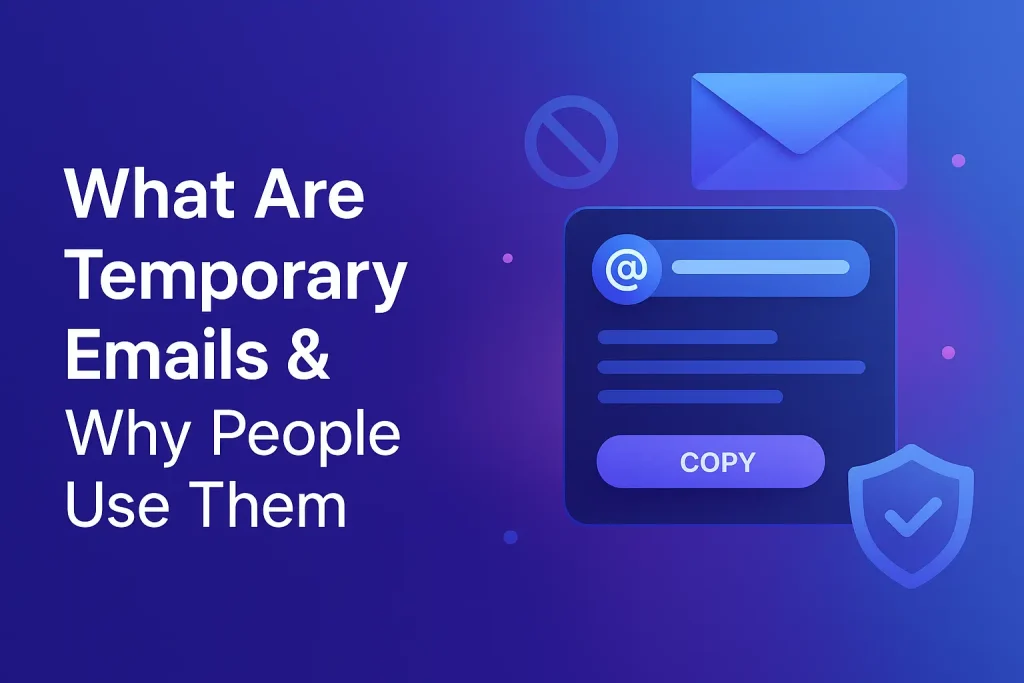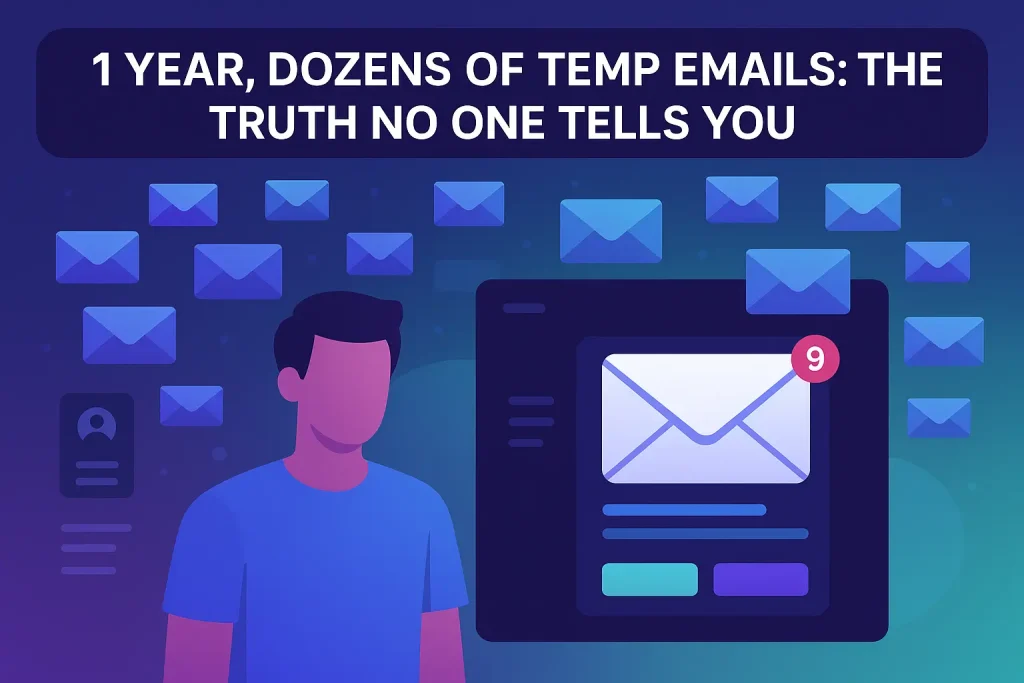Introduction
Why I Started Using Temporary Emails—and What Happened Next
If you’ve ever been overwhelmed by spam, tempted by free trials, or just curious about staying anonymous online, you’ve probably stumbled across temporary email services. That’s where I found myself about a year ago. My name is Juwel, and over the past 12 months, I’ve used dozens of temp emails—more than I’d like to admit. What I discovered went far beyond spam protection. This is my honest, unfiltered experience. No tech jargon, no sugarcoating—just the truth no one tells you.

1. What Are Temporary Emails & Why People Use Them
Temporary email services (also known as disposable emails or temp mails) are quick, anonymous email addresses that self-destruct after a short period. Many people use them to avoid spam when signing up for sites, downloading freebies, or trying out new platforms.
From my experience, they’re often misunderstood. To the public, they might sound shady—but the reality is, they can be surprisingly practical. I started using them out of curiosity, but what followed was an unexpected journey through convenience, disconnection, and digital identity.
2. My Initial Curiosity and First Use Case
It started small. I wanted a free PDF guide from a site I didn’t trust with my main email. I Googled “temporary email” and clicked on the first result—10 Minute Mail. Boom. An inbox. No sign-up. No name. It felt like digital magic. That first click became a habit, and that habit became a lifestyle.
3. Pros That Surprised Me
Here’s what no one tells you: temp emails feel powerful.
- Zero spam: My personal inbox became pristine.
- Speed: No registration, no setup—just instant email.
- Anonymity: I could browse and sign up without being traced. For a while, it felt like the smartest digital move I ever made.
“Privacy isn’t just about hiding; it’s about choosing when and where to be seen.” — Juwel
4. Hidden Downsides No One Talks About
But that freedom came with consequences I didn’t see coming.
- Lost access: Some services needed email verification later. No inbox, no login.
- Zero recovery: If I accidentally refreshed or closed the tab, the email was gone.
- Missed updates: Discounts, job opportunities—even one potential client—slipped through my digital cracks.
5. Emotional Burnout from Too Much Anonymity
I didn’t expect the emotional fatigue. Using fake emails all the time made me feel like I didn’t exist online. No personalization, no connection. I realized: hiding all the time can be just as exhausting as overexposure.

6. Real-Life Stories: Wins and Regrets
The Win: I once used a temp email to bypass a paywalled article for research. It saved me time and money.
The Regret: I signed up for a beta software using a disposable address. Two months later, they offered paid partnerships to early users. I missed the email—and the opportunity.
7. The Turning Point: When It Stopped Making Sense
Eventually, the novelty wore off. I couldn’t keep track of which temp email I used for what. One day, I needed to reset a password for a writing tool I loved—and I couldn’t. That was my wake-up call.
“When convenience becomes chaos, it’s time to reconsider the tool.”
I realized I wanted more connection and control in my digital life.
8. My Rules for Using Temp Emails (If You Must)
After a year, here’s how I use them more intentionally:
- Use them for: one-time downloads, untrusted sites, or quick form access.
- Avoid them for: anything involving money, work, or long-term value.
- Trusted Tools: TempMail, Maildrop, and Guerrilla Mail. Avoid services with unclear privacy policies.
9. Why the History Feature Matters
This is the game-changer I wish I’d had from day one.
Most temporary email providers offer limited access—once the inbox closes or expires, your emails are gone forever. But sometimes, that “disposable” email contains information you didn’t realize you’d need again.
- Forgotten logins: I’ve lost access to tools and accounts I signed up for with temp emails.
- Follow-up emails: A client or platform might reach out days or weeks later. Without history, you’ll never know.
- Download links & receipts: Many platforms send confirmation emails or access links that are time-sensitive—and gone if the temp email disappears.
Having a history feature means your temp email isn’t just a throwaway. It becomes a reliable extension of your digital toolkit.
10. My Recommendations
If you’re considering trying temporary emails or upgrading the way you manage them, I strongly recommend Tempmailcube.com. It’s not your average temp mail provider. What sets it apart:
- Safe & Fast: Their infrastructure is optimized for speed and privacy.
- Email History System: This is revolutionary—Tempmailcube lets you access your old temporary emails, even those that are 1 to 6 months old.
- Game-Changer: This history feature helped me retrieve important data from a temp mail I thought I’d lost. It’s a level of reliability I’ve never seen before in the temp mail world.
Whether you’re a casual user or a temp mail veteran like me, Tempmailcube bridges the gap between privacy and practicality. It’s the only service I now trust with serious intent.
11. Conclusion
After using temporary emails for a full year, here’s the bottom line: they’re useful, but not perfect. Temp emails gave me quick access, privacy, and control—but they also created issues I didn’t expect. I missed opportunities, lost important messages, and felt disconnected at times.
Would I repeat everything exactly the same? No. Today, I use temp emails only when it truly makes sense—like signing up for untrusted websites or quick trials. For anything important, I stick with my real email.
Thanks to smarter tools like Tempmailcube.com, I now get the best of both worlds: speed and safety without losing access to older emails. If you want to use temp emails wisely, that’s the way to go.
Key Takeaway: Don’t let short-term privacy cost you long-term value. Use temp emails with purpose—and make sure your email strategy fits your goals.
“Your inbox is more than just messages—it’s your connection to the digital world.” — Juwel
12. FAQs
Q: Are temp emails legal?
Yes, they’re legal in most countries. But how you use them matters.
Q: Can I use them for Netflix trials?
Technically, yes—but it violates terms of service. It’s a gray area.
Q: Are there secure temp email providers?
Some prioritize security, but none are truly safe for sensitive data.
Q: Do temp emails get hacked easily?
Yes. They’re public and shared. Never use them for personal or financial tasks.
Q: What if I lose access to a service?
You’re out of luck. Always think long-term before using a temp email.
13. Comparative Table: Temp Email vs Real Email
| Feature | Temp Email | Real Email |
|---|---|---|
| Spam Protection | High | Medium |
| Privacy | High | Low to Medium |
| Reliability | Low | High |
| Long-term Access | No | Yes |
| Identity Verification | No | Yes |
| Customer Support Access | No | Yes |
End Note from Juwel:
Thanks for reading my journey with temporary emails. If this post helps you make smarter digital decisions, I’ve done my part. Use tech, don’t let it use you. Stay sharp, stay informed—and most of all, stay you.
